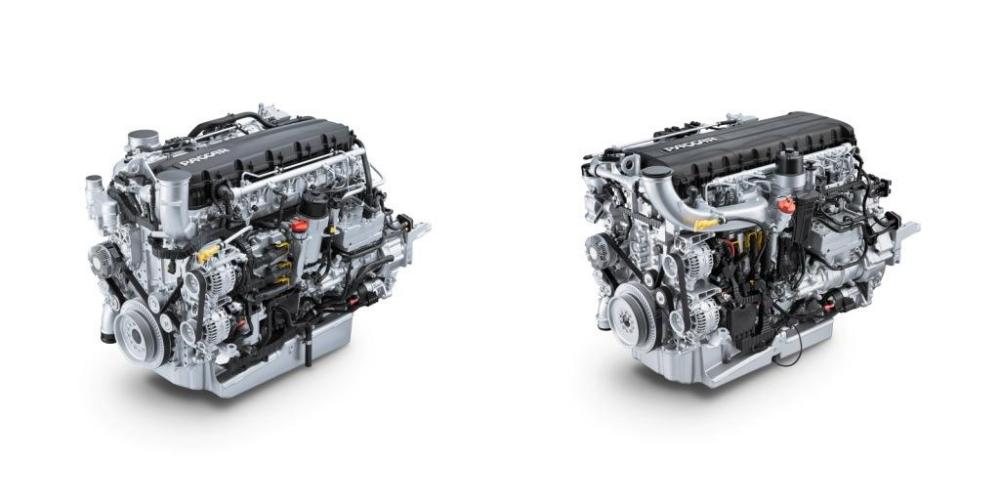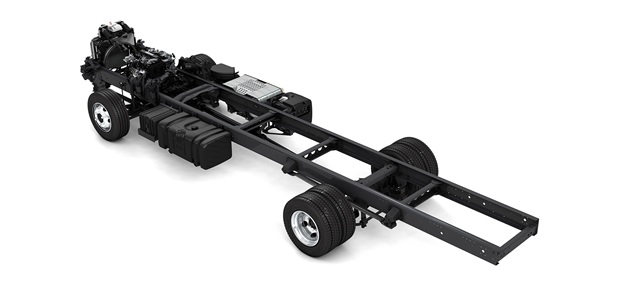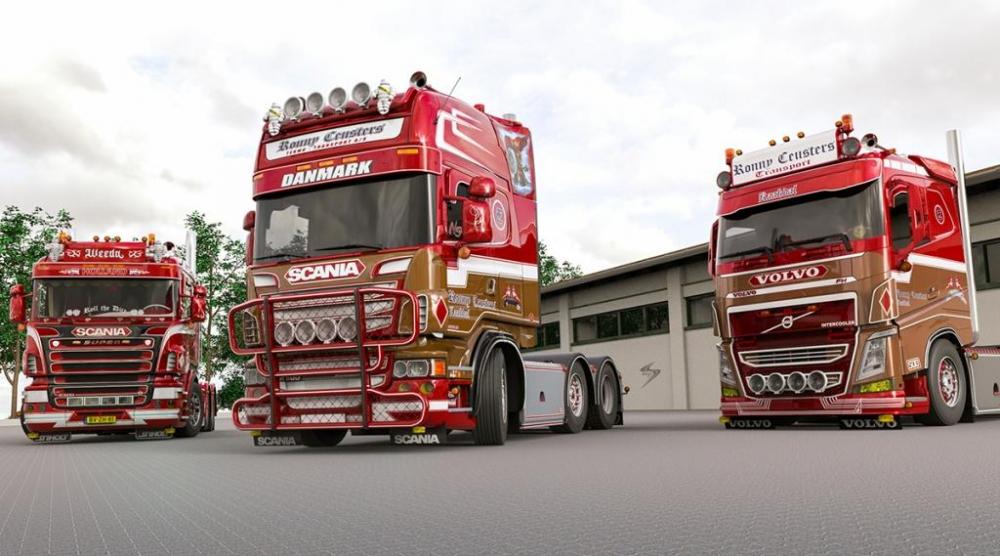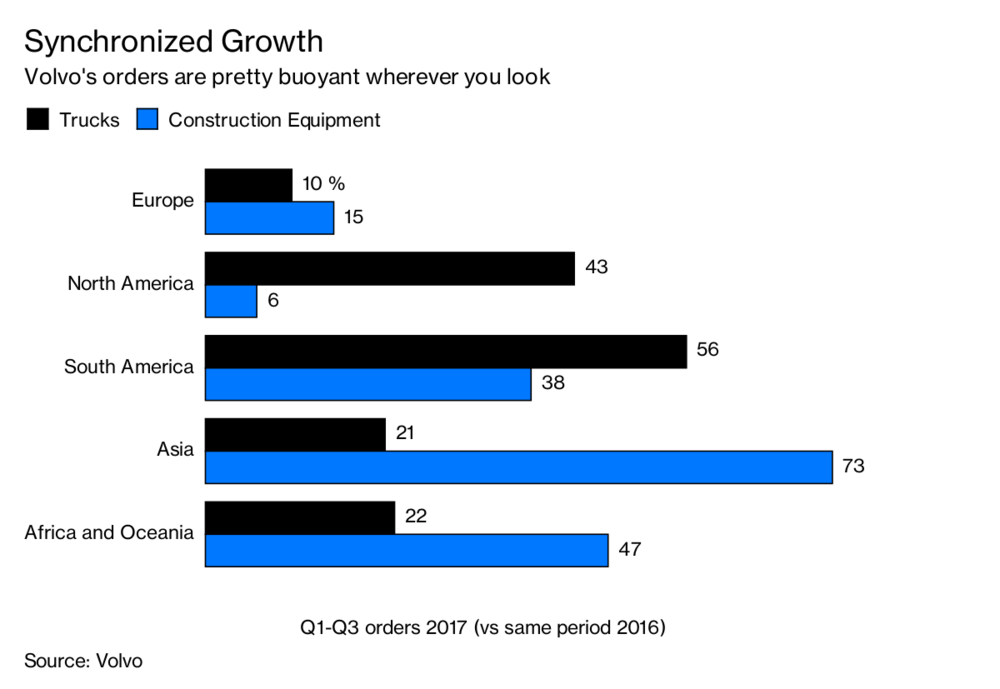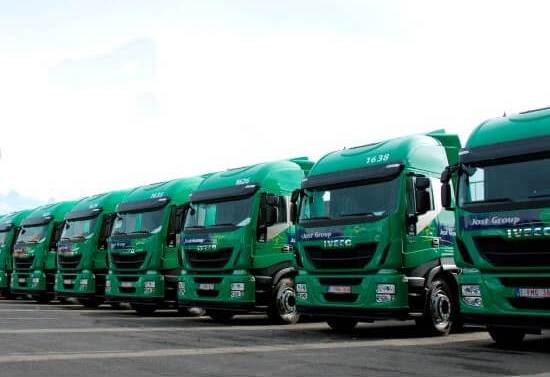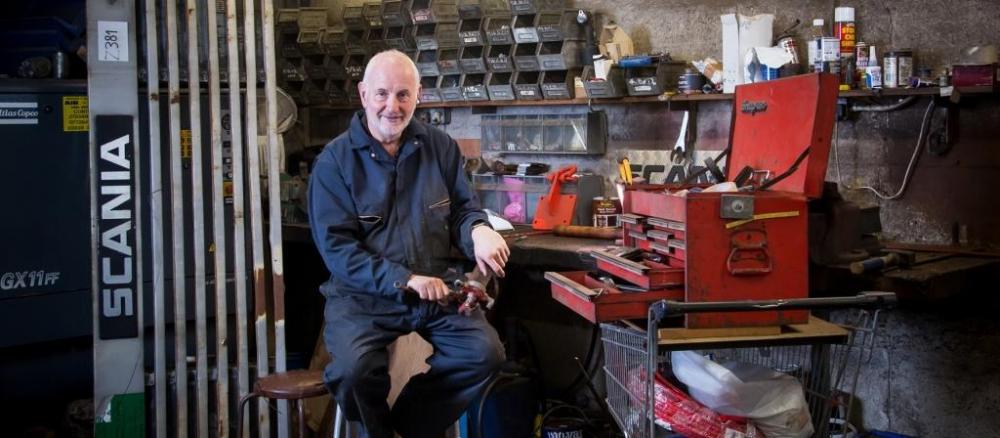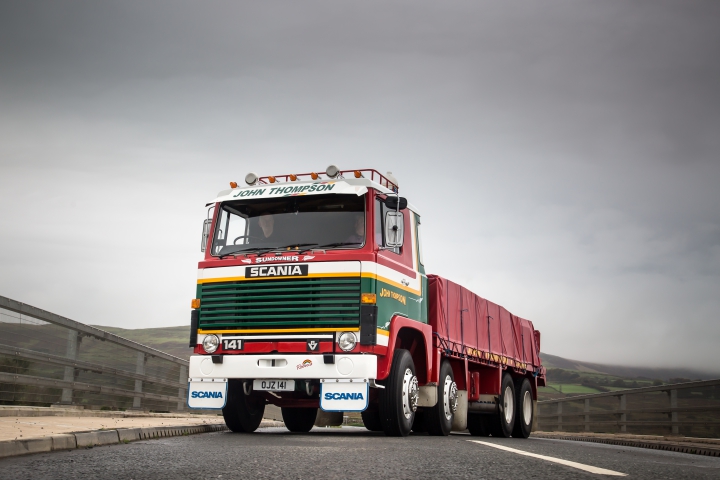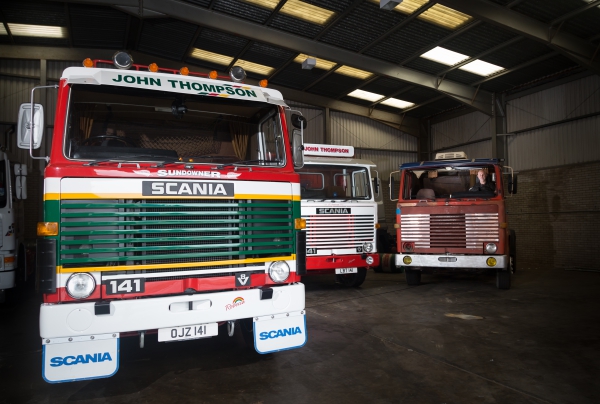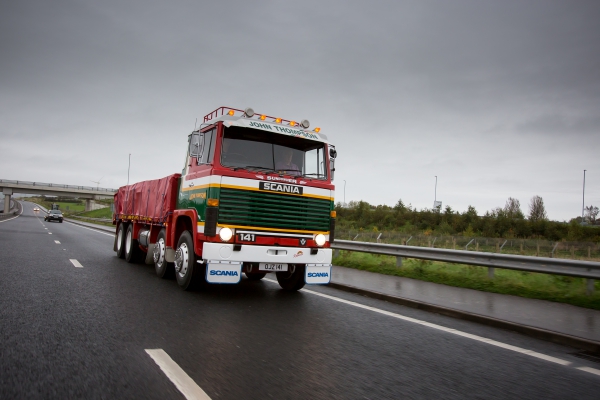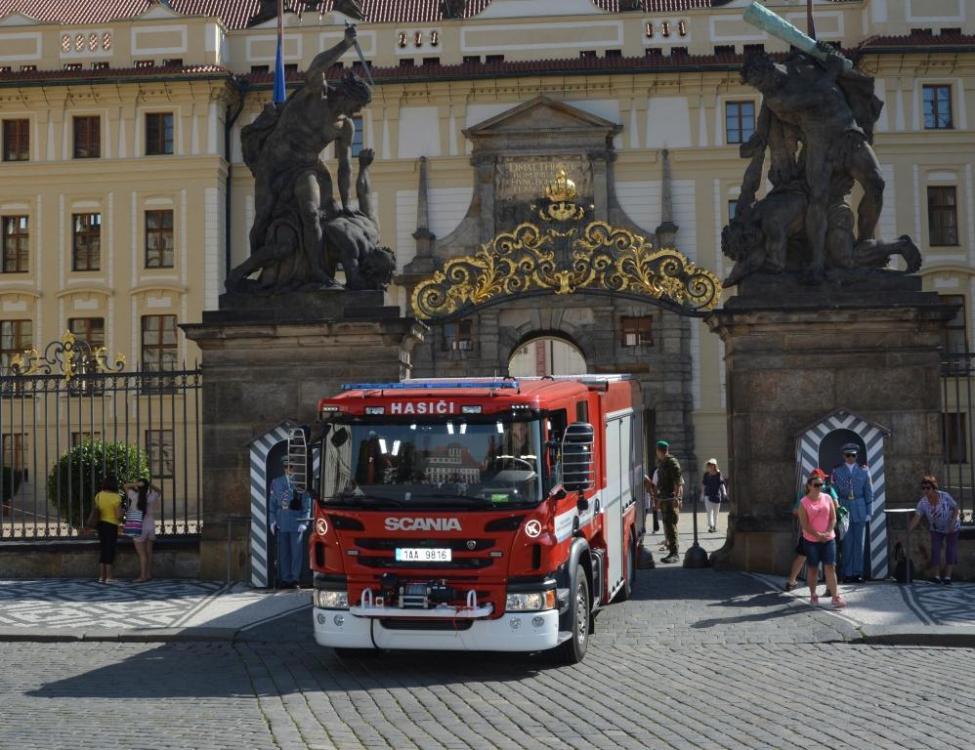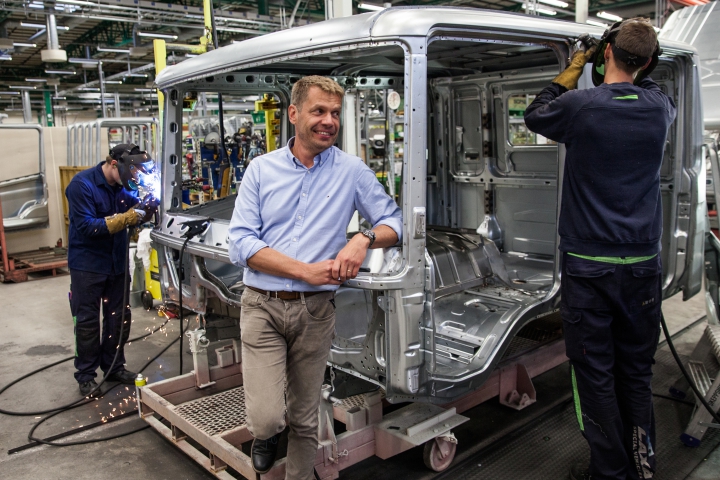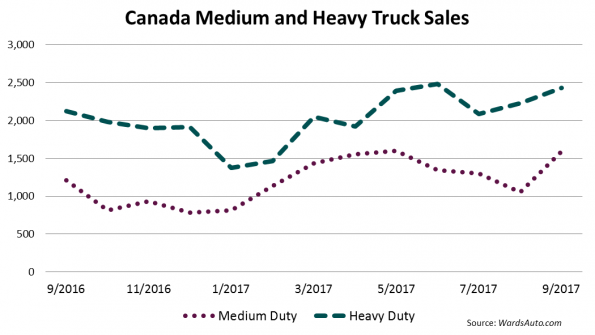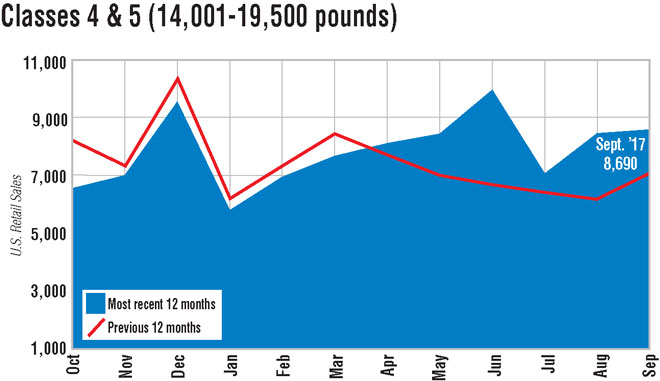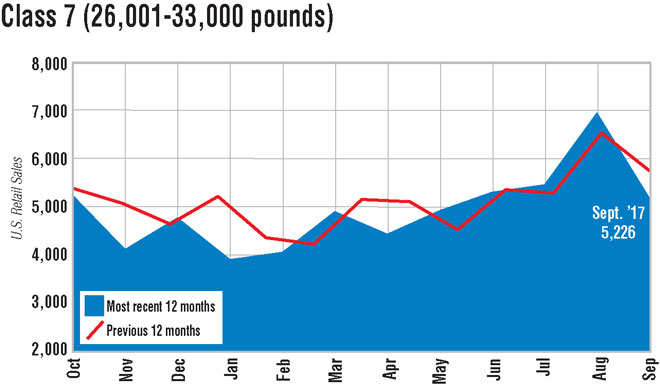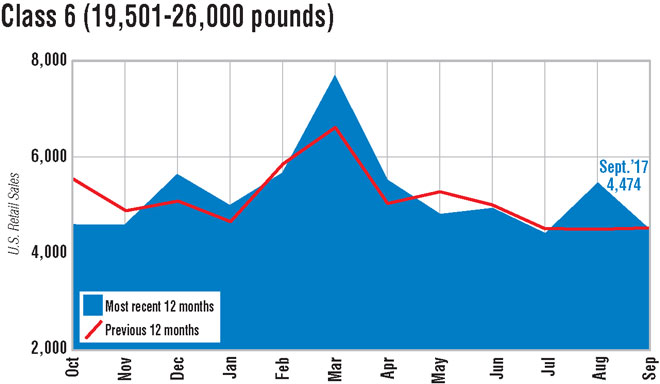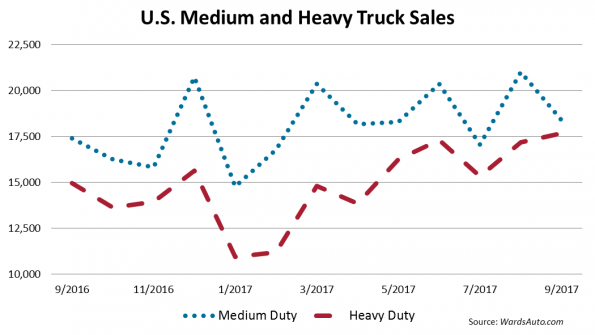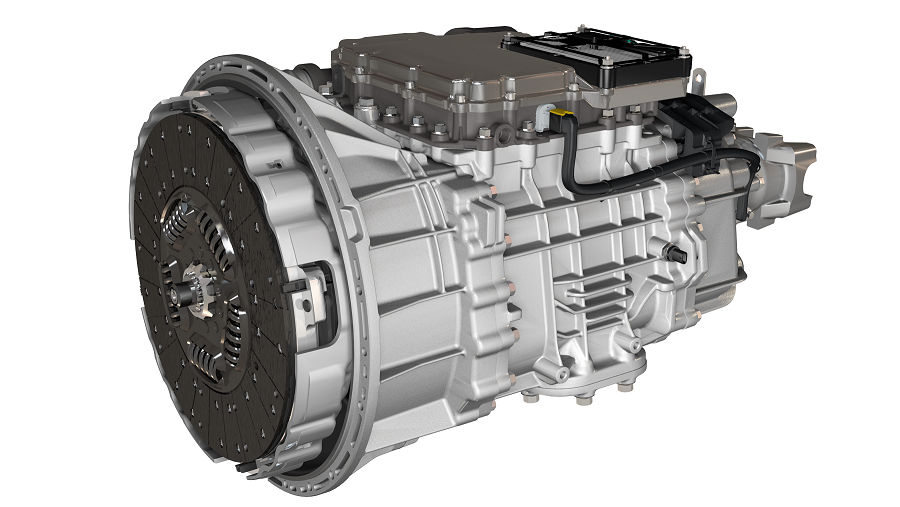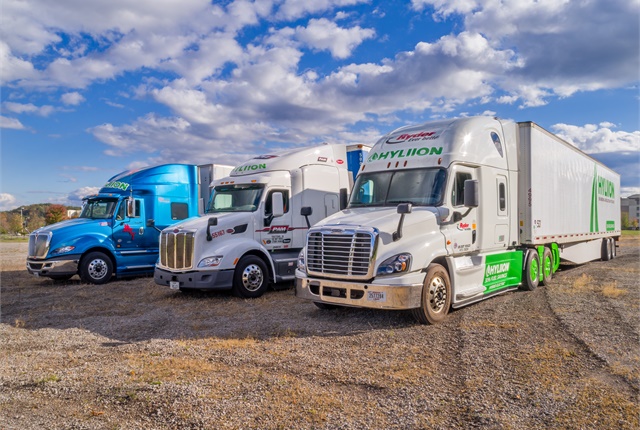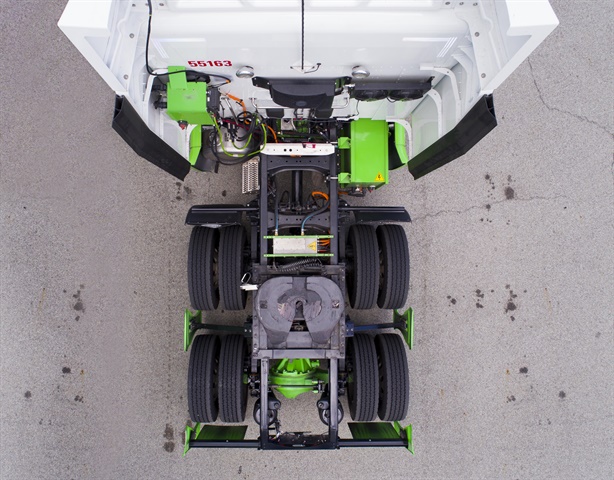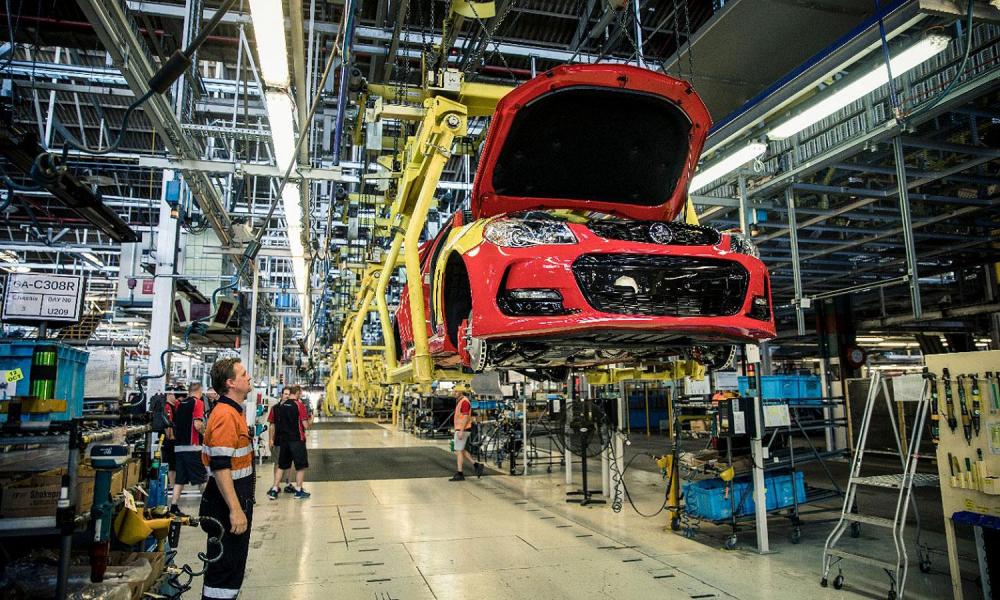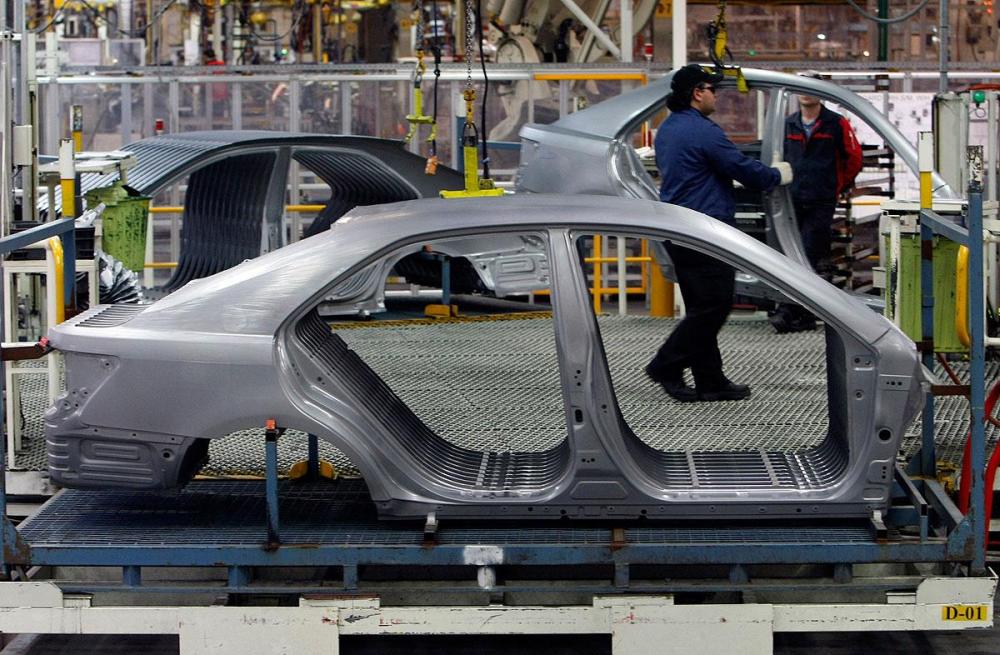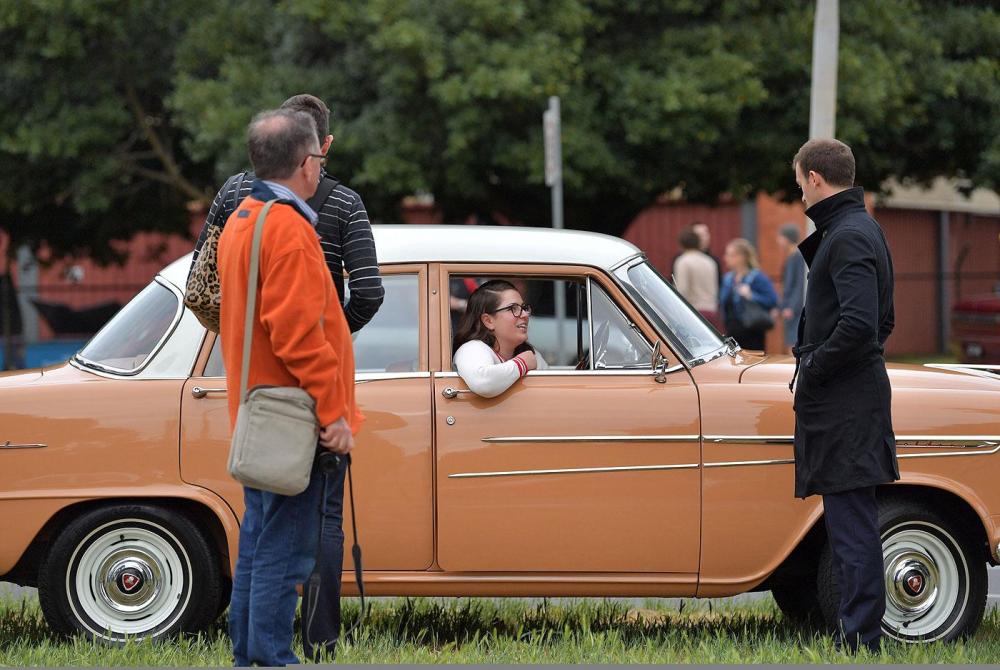
kscarbel2
Moderator-
Posts
18,885 -
Joined
-
Days Won
114
Content Type
Profiles
Forums
Gallery
Events
Blogs
BMT Wiki
Collections
Store
Everything posted by kscarbel2
-
MAN Truck & Bus at busworld: Solutions for the mobility of tomorrow MAN Truck & Bus Press Release / October 19, 2017 At busworld, in the Belgian city of Kortrijk, MAN and NEOPLAN will be exhibiting state-of-the-art city buses, intercity buses and touring coaches – vehicles that will form the foundation for the mobility of tomorrow. The highlight at the stand is the new MAN Lion’s Coach, which is celebrating its official debut at the fair. Link to full coverage - https://www.corporate.man.eu/en/press-and-media/presscenter/MAN-Truck-and-Bus-at-busworld_-Solutions-for-the-mobility-of-tomorrow--306433.html
-
DAF launches downspeeding power line components at Busworld '17 DAF Trucks Press Release / October 2017 Significantly more fuel-efficient, quieter, more powerful and more comfortable DAF Components introduces significant innovations at Busworld 2017 in Kortrijk, Belgium – downspeeding engines and accompanying axles for buses and coaches. The newly improved PACCAR MX-11 and MX-13 engines are incredibly quiet, providing optimum return at extra-low engine speeds. DAF is also introducing newly developed, extremely fast DAF rear axles, which - in combination with optimised transmissions - delivers exceptionally low fuel consumption and unprecedented travel comfort. DAF introduces downspeeding engines and accompanying axles for buses and coaches - Up to 6% lower fuel consumption - Greater comfort for passengers - Maximum torque available at 900 rpm Significant updates to PACCAR MX-11 and MX-13 engines - Reduced weight - New combustion system, turbo and new valve train - New intelligent pumps for oil, water and steering - More torque delivered at low engine speeds - Higher ratings up to 390 kW/530 hp - Leading engine brake performance New, highly efficient rear axles - Faster ratios - Reduced weight - Lower internal friction To ensure that every drop of fuel is used to maximum effect, DAF has taken a close look at every aspect of the power lines, asking, "how can we lower fuel consumption even further?" for new engines and new rear axles. The ultimate goal is to achieve maximum return, maximum reliability and maximum comfort for minimum costs. Downspeeding The starting point in the development of the new PACCAR MX-11 and MX-13 engines was to reduce speeds (downspeeding) in order to fully optimise fuel consumption. The new generation PACCAR MX-11 and MX-13 deliver their maximum torque from 900 rpm, without compromising performance. This means that it is possible for both the MX-11 and MX-13 to turn at around 1,050 rpm at cruising speed. High torque To ensure plenty of traction and a high level of driving comfort, even at the new, lower engine speeds, the torque on all new engines has been increased by 50 Nm to 200 Nm (depending on the engine type). The rating of almost every engine has also been increased by 10 kW/14 hp to 15 kW/20 hp. Innovations PACCAR MX-11 and MX-13 engines have been enhanced further to enable downspeeding. For both engines, components including engine block, cooling, air inlet, bearings for the crankshaft and pistons, have all been adapted. The combustion process has also been enhanced and the compression ratio increased. In addition, new and even more efficient turbos have been used, meaning that the engine delivers even more torque at low engine speeds while providing more efficient combustion. With a view to maximum efficiency, DAF is using a continuously variable oil pump, as well as a completely new oil module with reduced pressure losses. This newly-developed pump ensures that the oil pressure is always precisely aligned with the engine requirements, saving energy and thus fuel. The same principle also applies to the new continuous variable cooling water and steering pumps, which also help to reduce fuel consumption. Increased rating and torque The new PACCAR MX-11 engine comes with ratings of 220 kW/299 hp, 251 kW/341 hp, 270 kW/367 hp, 300 kW/408 hp and 330 kW/449 hp. The engine torque is 1,350 Nm and 1,500 Nm for the two lightest power lines. The most powerful MX-11 engine variants deliver a torque of 1,900, 2,100 and 2,300 Nm respectively. The ratings for the redesigned PACCAR MX-13 are 315 kW/428 hp, 355kW/483 hp and 390 kW/530 hp, with torque set at 2,300 Nm, 2,500 Nm and 2,600 Nm respectively. DAF engine brake sets benchmark The drive torque and rating of the engine are not the only aspects that are increased. The already leading MX engine brake on both the PACCAR MX-11 and the MX-13 has become even more powerful thanks to innovations on the valve train, including an adjustment to the cam profile. Just like the MX-11, this means the MX-13 now has an engine brake with 'single valve activation', which delivers more braking performance at a lower speed. It goes without saying that both engine brakes offer maximum performance over an extremely wide range of engine speeds. This not only limits wear on the brakes, but also delivers a higher average speed. The braking power of the PACCAR MX-11 is increased by 10% to 340 kW (463 hp). And even more important, the braking torque in the range between 1,200 and 1,500 rpm is increased by 20%. Thanks to these performance levels, DAF Components has set a new benchmark in the 11-litre segment. The engine brake on the MX-13 already delivered unrivalled power at low engine speeds and this has now been further enhanced. Between 1,000 and 1,450 rpm, the new MX-13 engine brake delivers 20% more braking power, peaking at almost 30% at around 1,200 rpm. The maximum braking power equates to 360 kW (490 hp) from 2,100 rpm. EcoMode For maximum fuel efficiency, the MX-11 and MX-13 engines can—in close consultation with the bus or coach builder—also be supplied with an Eco Fuel Mode. This engine setting is primarily aimed at achieving the lowest possible fuel consumption. For example, Eco Fuel Mode ensures that gear changes are made earlier and that the engine responds more moderately to changes in the position of the accelerator pedal. Eco Performance Mode on the other hand is designed for higher performance, making the engine more alert by delaying gear changes slightly and responding more powerfully. Newly developed cruise control The operation of the cruise control system on sloping terrain is also new. Here, Predictive Cruise Control (PCC) not only ensures gentle torque build-up, but also guarantees a faster torque build-up on steep inclines, to keep the road-speed as high as possible without compromising fuel efficiency. Eco Roll and Predictive Cruise Control have also been optimised. In the past, the truck would simply have decelerated just before the top of an incline. Now, the transmission is placed in neutral whenever the mass and speed of the vehicle are sufficient to push it over the incline with the help of kinetic energy. This significantly increases the rolling distances of the bus or coach and, on long routes, can actually more than double the EcoRoll share. Enhanced rear axles The layout of the complete power line is important for optimum vehicle performance and efficiency. For this reason, not only the engine has been fully enhanced, but—as part of DAF Transport Efficiency—so has the rear axle. This serves a dual purpose; to facilitate downspeeding and thus maximise efficiency and also to improve passenger comfort. The weight of the rear axle has also been reduced even more. The efficiency of the rear axle has been increased; not only by using new tooth profiles, but also by applying a new production process. This has maximised the accuracy of the gear wheel geometry, allowing friction between the individual gear wheels as well as the noise level to be minimised. DAF also uses an oil with a lower viscosity for both rear axles to reduce friction in the differential. Finally, rear axles benefit from newly-developed low-friction wheel bearings, which also deliver lower fuel consumption. Sustainable fuels for a lower CO2 footprint Sustainable fuels that ensure a lower CO2 footprint are becoming available in more and more locations. That is why DAF has ensured its PACCAR MX engines can be driven on HVO (the CO2 saving is 80%), BTL (80%) and GTL (5%). PACCAR MX engines can be filled with these paraffin diesels in addition to ordinary diesels, while still maintaining service intervals of up to 200,000 kilometres. DAF Components For decades, DAF has held a prominent position internationally for buses and coaches as a key partner of independent coach and bus manufacturers. DAF Components provides a complete range of Euro 6 engines; the PACCAR MX-11 and MX-13, including rear axle. All PACCAR engines distinguish themselves by low fuel consumption, optimum reliability and long service intervals for the highest vehicle availability and the maximum yield per kilometre. The same applies to the popular 9.2-litre PACCAR PR and 12.9-litre PACCAR MX engines, which are supplied for Euro 3, Euro 4 and Euro 5 emission standards. LF chassis module for compact buses The DAF Components range also includes the chassis from the DAF LF distribution truck, which forms an ideal basis for 30- to 40-seat PSVs. DAF supplies this chassis with a wheel base of 3.05 to 6.70 metres and with 4.5-litre PACCAR PX-5 four-cylinder and 6.7-litre PACCAR PX-7 six-cylinder Euro 6 engines – including ratings of 112 kW/152 hp to 239 kW/320 hp. The DAF LF chassis module is ideal for manufacturing a wide range of vehicles, ranging from compact midi buses to luxurious VIP coaches. Full service for optimum efficiency For optimum efficiency, it is important that a bus or coach is kept on the road as much as possible. Operators of buses or coaches featuring a PACCAR engine can call on the assistance of more than 1,000 DAF service points located across Europe and beyond, of which 200 are specially appointed as 'DAF Coach & Bus dealers'. These dealers are located along major routes for passenger travel and are fully equipped to provide services for systems that are specific to buses and coaches. DAF's International Coach Service is also ready to provide its services 24 hours a day, and DAF dealers offer repair and maintenance contracts for maximum reassurance before the journey commences. .
-
Chris Bryant, Bloomberg / October 20, 2017 It’s rare that major economies all grow at the same time. For investors that’s sometimes frustrating. There’s always at least one country—Brazil, Russia, wherever—blotting a multinational’s otherwise decent set of numbers. Not anymore. The Organisation for Economic Cooperation and Development says global economic momentum has picked up, in part due to increased business investment, with the upturn synchronized across the big economies. Industrial companies are starting to see the benefit. Take VolvoAB. Its third-quarter update was a sea of green. Truck and construction equipment orders rose 32% and 45% respectively in the three-month period (compared to a year earlier). Encouragingly, that growth comes not just from China but is much more broadly based. “Market demand is strong,” Martin Lundstedt, Volvo’s chief executive, said, noting that even the long-suffering Brazilian heavy duty truck market is bottoming out. Daimler AG’s truck business is roaring ahead too. Its sales rose 30% in the third quarter, with increases in previously tough markets such as Indonesia, India, Turkey and Brazil. Volvo’s truck orders have been so good that its supply chain is struggling to keep up, leading to extra cost for things like express delivery and overtime. Not that shareholders care too much about that: The stock surged almost 7%. When Volvo’s products are selling well, it means the global economy is probably doing OK too. Investors shouldn’t be the only ones starting their weekend on a more optimistic note. True, there was a dip in North American construction equipment orders in the third quarter but management explained that was due largely to the introduction of new products a year ago (hence a tough comparison). .
-
Volvo shares hit record as earnings top forecasts on surging truck demand Reuters / October 20, 2017 STOCKHOLM - Sweden’s AB Volvo reported a bigger-than-expected rise in quarterly core earnings on Friday as stronger demand for heavy trucks more than offset costs stemming from strains on its supply chain, sending its shares to a record high. Sweden’s biggest manufacturer by sales also raised its outlook for truck markets on both sides of the North Atlantic this year and forecast a further strong recovery in sales of commercial vehicles in North America in 2018. “These are blow-out numbers,” said analyst Hampus Engellau at Handelsbanken Capital Markets, which rates the stock “buy”. Shares in Volvo rose 7.0 percent by 0800 GMT, leaving the stock up 56 percent so far this year. Volvo and rivals in the truck industry such as Germany’s Daimler and Volkswagen have hit a sweet spot this year, with rising or already robust demand in all major commercial vehicles markets. The broad upturn in demand was also in evidence in Daimler’s quarterly results, also released on Friday, with a double-digit rise in deliveries and a 32 percent jump in earnings at its trucks division. Yet the buoyant demand has also come at a cost, with pressured supply chains leading components maker SAF-Holland to scale back its 2017 margin outlook this month, while Volvo’s profitability was dented in the second quarter. CONTINUOUS IMPROVEMENT Volvo said stretched components supply had continued to have an impact in the third quarter, but with a 13 percent rise in truck deliveries and sharply higher earnings in its construction equipment arm, this was shrugged off. CEO Martin Lundstedt, a former boss at rival Scania, said the bottlenecks that had mainly hit European truck manufacturing had eased somewhat in recent months, along with supplies of components for powertrains, or engines and axles. “Still there is obviously a high level of pressure in the supply chain, but if you look through the quarter and after the vacation period it has been a continuous improvement, and we continue to see that,” Lundstedt told a news conference. Volvo’s adjusted third-quarter operating profit rose to 7.02 billion Swedish crowns ($861 million) from 4.85 billion a year before, beating a mean forecast of 6.20 billion seen in a poll of analysts. ”There are really no negatives here,“ Engellau said. ”Construction Equipment is really strong and the trucks business continues to deliver in a seasonally weak quarter. “Also order intake is extremely strong and it seems demand will accelerate even further ahead.” Volvo has begun reaping the benefits of a 10 billion crown cost-cutting drive and in August set a target to reach its highest profitability since the sale of its car making arm to Ford (F.N) nearly two decades ago. Gothenburg-based Volvo said order intake of trucks at the group, which also includes brands such as Mack, Renault and UD Trucks, grew 32 percent in the quarter, beating the 15 percent rise seen by analysts.
-
IVECO Trucks Press Release / October 20, 2017 One of Europe’s largest transport and logistics companies places major deal for IVECO’s natural gas-powered heavy trucks – confirming its confidence in Liquefied Natural Gas (LNG) to replace diesel IVECO has secured the largest deal for Stralis NP vehicles to-date, with 500 new trucks set to enter operation with the pan-European transport and logistics specialist, Jost Group. Designed to be the most sustainable long-distance heavy truck ever manufactured, the new deliveries will run on LNG – widely regarded as the only currently available mass market alternative to diesel. The 500 Stralis NP trucks powered by LNG will offer an excellent power-to-weight ratio, power density and quietness of operation. The first 150 vehicles will enter operation during 2018, with the full fleet to be in service by 2020. They will replace 4 to 5 years old diesel-powered vehicles in the Belgian firm’s fleet of 1,400 trucks and 3,000 trailers, which has grown steadily following a series of acquisitions. The company already operates 132 Stralis vehicles, including two running on compressed natural gas (CNG). Commenting on the agreement, Roland Jost, Owner of Jost Group, says: “This marks a key turning point for our business as we begin a strategic move away from our dependence on diesel and towards green logistics, as requested by our customers, which are demanding a more sustainable transport. Our excellent experience operating Stralis Euro 5 EEV diesel vehicles has seen us establish a solid relationship with IVECO, supported by a very strong service network across Belgium. “This played a key role in our decision to take the next step on the path to sustainability, choosing the IVECO Stralis NP as the best solution. We’re proud to be amongst the early adopters of this new technology: our goal for the next three years is to have 35% of our fleet running on LNG. Our Group is also supporting this with an investment in our own LNG refueling infrastructure, with plans to open up to three filling stations within our major operating centres in Belgium.” Pierre Lahutte, IVECO Brand President, explains: “Gas offers the widest range of opportunities to replace diesel in the commercial vehicle market – it's no longer a fuel of tomorrow, it's a fuel of today. This has been firmly demonstrated with one of Europe’s biggest fleets selecting the Stralis NP, running on LNG, to lead their fleet replacement programme. Jost Group has clear sustainability goals, and recognises the benefits that our advanced experience in natural power vehicles can bring to its operation. We are extremely pleased to be growing our share of their fleet, and introducing the Stralis NP and LNG into their operations.” Demand for LNG is growing rapidly across Europe, with the German Ministry of Transport and Digital Infrastructure (BMVI) having identified LNG as the best solution for long-distance road transport in the short term and for the next 10 to 15 years. When running on fossil derived natural gas, the Stralis NP’s CO2 emissions are up to 10% lower than its diesel equivalent, depending on mission and gas composition – rising to up to 95% lower with the use of biomethane. With IVECO’s natural gas technology, the level of particulates are negligible and the NOx 50% lower compared to diesel over long haul missions. It is also much quieter, reducing engine noise levels by around 50% – aiding deliveries in urban areas. IVECO was the first manufacturer in the world of commercial transport to recognise, in 1991, the potential of natural gas – foresight that saw the company develop a full range of natural gas-powered trucks, vans and buses. Today, more than 22,000 IVECO gas-powered vehicles have been sold. Jost Group is a family business employing more than 2,800 members of staff, with offices spanning 10 countries in Europe and North Africa. It offers full, partial and bulk loads, including dry freight and temperature controlled cargos, plus the movement of containers, dangerous goods and waste. Jost Group is also the international key-partner in inter-modality, in air & sea freight and warehouse logistics, with its 300.000m2 of interconnected warehouses. .
-
DAF Trucks: PCC Predictive cruise Control and Predictive Shift
kscarbel2 replied to kscarbel2's topic in Trucking News
-
. .
-
Yes, Billy. They were built as long wheelbase 6x4s, and then converted in New Zealand to twin-steer configuration with the addition of a second steer axle. The roof rack wasn't uncommon on 141s for storing luggage. as it freed up cab space. If you're running from Ireland to Iran, the more clothes the better. These trucks had the Scania version of the Mack END865/866 V8, simultaneously introduced in 1969. The Scania version featured individual cylinder heads, versus four paired heads.
-
Scania Group Press Release / October 18, 2017 Truck enthusiast John turns detective to find and collect unusual vintage Scania 141 truck. For many people, retirement is a time for a well-deserved rest after all the stresses and strains of a working life. But for avid Scania truck enthusiast John Thompson, retiring from his job as owner of an Irish transport company eight years ago meant he finally had time to turn detective: to indulge his hobby of tracking down, then buying and restoring Scania 141 vintage trucks. John’s enthusiasm for Scania 141s goes back to the start of his career, when he was working as a factory-trained mechanic at a Scania dealership near his home in Larne, Northern Ireland. “I was about 20 or 21 years old, and it was an impressionable time for me,” he recalls. “The Scania 141 was the flagship vehicle for Scania back then, and I really enjoyed working on them in the workshop. The memory stayed with me, and I’m nowadays a member of a vintage 141s club based in Ireland.” Tracking down a rare truck Over the years John has collected Scania 141 tippers and other trucks in the range, but there was one particular vintage truck that caught his eye. “I started to do some research, and I found out that in the early 1980s Scania had exported right-hand drive 6x4s to New Zealand where they were fitted with a second steer axle, giving them four axles overall. They did that because New Zealand had a low axle weight allowance, so most vehicles had four axles.” Fewer than ten of these specially-adapted machines were ever built, as they proved too expensive and heavy to compete against the other brands on the New Zealand market. Three decades later, it took John seven years of detective work to find a rare vintage Scania 141 in New Zealand with the required specifications. He was so excited that he bought it over the phone without seeing anything more than a photo and the seller’s description. But that was only the start of the process. Transporting a vintage Scania across the world “I thought to myself ‘How am I ever going to get this home?!’”, says John, which was no mean question, considering the size of the truck and the 18,000 kilometres that separate New Zealand from Northern Ireland. In the end, he found a shipping transporter going to Japan, with the truck being dropped off at Singapore along the way. Then another transporter took the Scania 141 to the English port of Bristol, with the shipping of such a long and rigid vehicle costing him over 10,000 GBP. From there it was picked up and driven back to Larne. It was all worth it, though. “When we got it to the depot and I saw it for the first time, I wasn’t disappointed,” says John. However, the detective work has not stopped there. John found a photo of the 141 truck when it was brand-new, and repainted it in the original colours and coach lines, even restoring the ‘Sundowner’ name that was applied to the vehicle by its first owner (Sundowner means drifter in New Zealand slang). Wowing the crowds at truck shows After a little work, the Scania 141 has passed its British MOT test, so it is being driven to truck shows up and down Britain and Ireland, including the Convoy in the Park festival held in England in July. “It gives me great satisfaction to take the truck to the shows, lock it up and leave a card that explains the truck’s history, then go for a walk round the site and come back to see folk walking around it and taking photos,” says John. Our truck detective is now on the lookout for the remaining New Zealand Scania 141s. He even got a bit of help from Scania recently, when the company provided him with a sales record of the original shipments. If he can track down more of them, it’ll certainly make the other guys in the 141 owners club envious! .
-
Scania Group Press Release / 13 October 2017 Quality, tailor-made services and modern technology were crucial factors when the PragueCastle fire department chose two Scania P 480 fire trucks for its operations. Scania has a long history of supplying dependable trucks to fire and rescue crews. The latest city to benefit from these vehicles is Prague, two P 480s were recently delivered to the capital for the protection of the city’s castle. “We especially appreciate Scania’s quality, it guarantees long lasting and trouble-free operations as well as superior services tailored to our needs,” says Jan Schreiner, Deputy Commander at the fire department of PragueCastle. “Besides a very attractive vehicle design, I have to emphasize the modern technology, safety elements including ESP (Electronic Stability Program) and the roomy crew cabin. We can also see how well the chassis is prepared and together with the body it creates a highly functional and compact package.” Coldcut Cobra technology The lightweight P-series trucks are engineered for maneuverability, economy and speed. The delivered trucks have adjustable air suspension and are equipped with Coldcut Cobra C 360 Kit – a fire extinguishing technique that rapidly penetrates all known construction materials. “PragueCastle is the most visited monument in the CzechRepublic, so there is an enormous emphasis on safety. I am very pleased that the fire department of the Prague Castle chose our vehicles, which only confirms their quality,” says Petr Smola, Sales Manager of Scania special vehicles, Czech Republic and Slovakia. And more trucks are on the way to the Czech capital; the city’s fire brigade recently made its own order. .
-
Scania Group Press Release / 13 October 2017 A job that would take ages at the production facility in Södertälje is completed at Laxå Special Vehicles in just two weeks. All work on special versions of cabs and chassis is carried out in a red brick building in the former railway hub with its 3,000 inhabitants in NärkeCounty. “Scania can do everything we can, but it takes a long time for them to put it into production. If a customer wants a sixth axle fitted, we fit it. Essentially, we never need to turn down a customer who wants their vehicle converted,” says Håkan Larsson, the departing Managing Director. 1,200 years’ combined experience The strength of the organisation is its ability to cope with complex orders. Whether this is because the employees have almost 1,200 years’ combined experience of special-purpose vehicles or because the longer “takt time” means that there is more scope for devoting extra attention to the vehicles or a combination of the two – the job gets done. Scania will once again become the majority shareholder in Laxå when Larsson leaves the company after having worked there for almost 30 years. He has now done most things many times over and feels ready to let someone else take over – for the sake of his own development and that of the company. “We’ve always had good backing and support from Scania, but at a bit of a distance,” says Håkan. The challenge that lies ahead is to remain true to the basic concept: that of being the agile little company that is simultaneously growing. “Being as successful as we’ve been is a curse in itself. We need to retain our identity. If we become too much like Scania, we’ll lose what makes us unique,” says Larsson. Bought out Scania Laxå was established in 1999 when Larsson and his colleagues, Lasse Forsberg and Anders Gruffman, bought out Scania. There was a decline in the number of projects and they were concerned about the business. “We thought we could do it better ourselves locally, and what was needed was entrepreneurship,” says Larsson. It was with a nervous handshake that Larsson and his colleagues sealed the deal with the then MD of Scania, Leif Östling, who is reported to have said, “Lads, you now need to start rowing”. And they have kept on rowing ever since. The company, which was founded back in the 1960s under the name of “Fordonsskräddarna i Laxå”, has grown from 40 employees when Larsson, Forsberg and Gruffman took over to the current 150. “In the first year, we built three vehicles in our chassis workshop. This year, it will be 500,” says Larsson. Started as an assembler They were tough years, but Larsson is from the region himself and started working at the company in 1989 as an assembler. He has been both a design engineer for the current cab generation and CrewCab and been involved with no less than three generations of Scania trucks. Something Larsson keeps coming back to is the workforce, which he believes is what makes Laxå SV such a great company. “You can find machinery and equipment anywhere, but not the sort of expertise we have. It’s a mind set that lives and breathes flexibility,” he says. Today, there are many new people at the company, but there is a solid nucleus and plenty of knowledge is being passed on. Laxå is like a miniature version of Scania, but more specialised. Whether they’re building a 7-axle truck for China that has to accommodate the largest concrete pump in the world, or working on one of Svempa’s customised vehicles, it’s all in a day’s work for Laxå SV. “This is Scania’s strength and ours too: people who like their company help each another to progress. We’re like a family company and everyone is close by,” says Larsson. A note that stood out Larsson explains how an employee had gone to Scania for a meeting, which was held beside one of their many planning boards. There were around 800 Post-it notes on the board – or at least a very large number. But there was one note that stood out. A note on which someone had drawn a big heart. “In the middle of it was Laxå. That’s how I feel. I like Scania. But I love Laxå,” he concludes. .
-
Wards Auto / October 12, 2017 Canada big truck sales continue to rise, up 15.9% to 4,014 in September, for a seventh straight monthly year-on-year gain. This compares to like-2016’s 3,330, leaving 2017 with a strong 12.0% lead in year-to-date sales totaling 30,265. Heavy-duty truck sales reflect similar results. Up 9.8% in September, Class 8 sales hit 2,426 units, compared with year-ago’s 2,124. Daimler and International dropped 1.3% and 5.6%, respectively. PACCAR’s Kenworth (+25.4%) and Peterbilt (+33.5%) posted large gains. Similarly, Volvo Truck’s Mack and Volvo brands also outperformed this month, with gains of 43.9% and 14.5%, respectively. With four straight months of year-over-year increases, Class 8 sales totaled 18,427 deliveries through the third quarter, 6.9% ahead of last year. Classes 4-7 sales were up 26.6% with 1,588 deliveries in September. Year-to-date sales are up 21.0%, to 11,838 deliveries. The only sector to see a drop for the month, Class 7 came in 3.7% below 2016 with 674 units. Double-digit losses for Ford (-55.6%) and International (-18.8%) were offset by a 64.5% gain by Freightliner and 65.4% increase by PACCAR. Sales in Class 6 totaled 120 in September, up 8.9%. Freightliner dropped 14.5% to 24 units. Hino remained flat at 56 units, while Ford doubled its sales from six to 12. PACCAR soared 380.8% on small volume. Class 5 deliveries spiked 67.3% with 581 units sold. Isuzu enjoyed a triple-digit gain of 182.3%. FCA was up a solid 35.5% to 93 units. No.1-seller Ford nearly doubled its sales, up 96.6%, while International recorded the worst performance, down 42.3%. Class 4 was the top performer with a 120.2% jump to 213 deliveries, compared to like-2016’s 93. Isuzu’s import line had the largest sales gain, up 348.7% in September. Ford soared 138.8% to 154 units, and maintained its strong share lead with a 72.3% take. Hino boosted sales 60.3%. With large gains from all truck makers, year-to-date sales for the class are ahead 39.6% with 1,619 deliveries. .
-
U.S. Medium- and Heavy-Duty Truck Sales Still Trail Year-Ago
kscarbel2 replied to kscarbel2's topic in Trucking News
Medium-Duty Sales Ride Classes 4-5 to Gains in September Transport Topics / October 18, 2017 Sales of medium-duty trucks rose 5.8% in September, led by sales of trucks in two of the lightest classes, WardsAuto.com reported. Sales of Class 4 and Class 7 trucks reached 18,390 compared to 17,389 a year earlier. Year-to-date, sales were up 5.5% to 165,201. Continuing the trend from August, sales of Classes 4-5 trucks posted the biggest gains, up 22% in September to 8,690 units, according to Ward’s. “Class 4 is a market that was disproportionately impacted by the recession back in 2008 through 2010. Not only was it the recession, but that [truck class] tends to directly serve the housing segment of the economy. So it was particularly beat up,” Steve Tam, vice president of ACT Research Co., told Transport Topics. “Class 4 is still a shadow of its former self, but it’s making progress and coming back, and there are new entrants in that space. We are seeing the life being breathed back in to that customer space,” Tam added. Year-to-date sales in September for Class 4 trucks were 13,495, according to Ward’s — just below the 14,473 posted in the same period in 2009. But that doesn’t compare to 38,746 sales in the same nine-month period in 2007. Meanwhile, General Motors’ Chevrolet brand began offering an LCF Class 4 truck this year and achieved sales of 1,233 units in the first nine months. New products were moving into the Class 4 space just as the market was crashing with the recession, Tam noted. At the same time, Class 7 sales fell 8.7% to 5,226 compared to 5,721 a year earlier. Freightliner, a unit of Daimler Trucks North America, claimed the top spot with 2,424 truck sales, good for a 46% share. International sold 1,666 Class 7 trucks, earning a 32% share. Also, Peterbilt Motors Co. sold 513 trucks. Kenworth Truck Co. sold 349. Both are brands of Paccar Inc. and, combined, gave their parent company a 16% share of the Class 7 market. Hino Trucks, a division of Toyota, with 153 sales and Ford Motor Co.’s 121 sales accounted for the balance. Class 6 sales slipped 1.6% to 4,474 compared to 4,547 a year earlier. Freightliner led with 1,496 sales, a 33% share. Ford nipped at Freightliner’s heels, selling 1,263, for a 28% share. International earned a 19% share with sales of 846 units. Ford Motor Co. dominated Class 5 with 4,742 sales out of a total of 7,105. . -
Wards Auto / October 12, 2017 Up 7.1% in September, U.S. big-truck sales grew to 36,057 units compared with 2016’s 32,357. With four straight months of year-over-year gains, total sales through the third quarter are slowly approaching last year’s number (304,994) but falling 1.7% short with 299,682 deliveries. Class 8 helped narrow that gap with a 13.5% jump in sales to 17,667 units. Truck makers continue to try to make up for the losses experienced in the first six months of the year, since it wasn’t until July when sales in Class 8 finally started to grow. Volvo Truck, one of the only truck makers in this group to underperform, came in 11.5% below prior year with its Mack and Volvo brands dropping 8.1% and 14.5%, respectively. Kenworth (-7.4%) also declined in sales, but sister brand, Peterbilt, made up with a 16.3% jump, leaving parent company PACCAR with an overall gain of 3.0%. Group leader Daimler led the way with 43.4% market share and 7,665 deliveries, a 34.9% boost gained from Freightliner (+35.9%) and Western Star (+19.3%). International also put up positive numbers, a 19.3% increase to 1,995 units. U.S. medium-duty truck sales grew a modest 1.7% to 18,390 units. Large gains from Classes 4 and 5 kept the year-to-date total 6.2% ahead of last year with 165,201 deliveries. Class 7 sales fared the worst among all segments, with a 12.2% dive to 5,226 units. International was the main downward force, as sales slipped 28.2%, losing 7.1 percentage points in market share. Ford was the only maker to gain in this segment, growing 3.9%. Sales in Class 6 fell 5.4% on mixed results. Volume-leader Freightliner inched up 1.9% while runner-up, Ford plummeted 22.6%. Peterbilt was in the red, down 63.4%, but accounted for only 0.2% of the segment. Kenworth reversed the negative impact on PACCAR’s total, gaining 30.0% and bringing the parent company’s sales up 21.0% overall. With domestics up 11.3% and imports, 14.9%, sales in Class 5 grew 11.7% to 7,105 units. Accounting for only 0.1% of the segment, International was the only truck maker to fall short, down 82.1%. Ford rose 10.9% in sales with 66.7% market share. Runner-up FCA grew 6.9%, and taking up 16.8% market share. Class 4 enjoyed the best performance in September, up 51.8% on sales of 1,585 units. Triple-digit gains were posted by GM’s domestic line (+684.0%) and Mitsubishi Fuso (335.2%). Ford also increased its share of the segment with a 125.2% sales jump, good for a 16.0% stake of the segment. Continuing the streak since May, Class 4 sales have seen large year-over-year gains, resulting in a 31.0% gap through the third quarter with 13,495 deliveries compared to prior year’s 10,300. Class 8 inventory at the end of September hit 40,501, resulting in 60 days’ supply, down from last year’s 68. Medium-duty truck makers ended the month with 59,526 units in stock, an 84 days’ supply, above like-2016’s 80. .
-
Renault Trucks is, clearly, the best performing brand they have. And yet, Volvo treats Renault people as if they couldn't possibly know anything about trucks (sound familiar Mack brand distributors?).
-
The Electronic Logging Device (ELD) Controversy
kscarbel2 replied to kscarbel2's topic in Trucking News
FMCSA Grants UPS Several ELD Exemptions Transport Topics / October 19, 2017 The Federal Motor Carrier Safety Administration will grant UPS Inc. temporary exemption from parts of the upcoming electronic logging device mandate, according to a document scheduled for publication in the Federal Register on Oct. 20. The federal ELD rule, published in December 2015, requires motor carriers who currently are required to maintain paper records of duty status to start using ELDs for hours-of-service compliance. The mandate takes effect Dec. 18. FMCSA granted UPS several five-year exemptions in four chief areas, namely the use of automatic onboard recording devices during the “phase-in” process, as well as data collection methods for drivers who log out of an ELD while outside a vehicle, drivers who make yard moves and nondriver employees who operate vehicles. FMCSA published notice of UPS’ application for exemption June 9. UPS ranks No. 1 on the Transport Topics Top 100 list of the largest North American for-hire carriers. UPS requested continued use of the AOBRDs as the company converts its fleet to ELDs on a site-by-site basis. According to the company’s application, UPS oversees 2,800 tractors at 35 sites. Moreover, the company plans to purchase 1,530 new tractors in 2018. FMCSA granted the request, as the agency’s safety regulations state “a motor carrier that installs and requires a driver to use an automatic onboard recording device before December 18, 2017, may continue to use the compliant automatic oboard recording device no later than December 16, 2019.” However, the agency cautioned that if UPS replaces fleet vehicles, the company must install AOBRDs that were used in previous truck rather than purchase new ones. FMCSA also granted a request for truck operators who use portable, driver-based ELDs. The application states that UPS drivers, on the whole, are paid by the hour and punch into work at UPS facilities, rather than in a vehicle. Because UPS drivers perform duties outside of their vehicles, such as attending meetings and walking to dispatch centers, workers technically are “on the job,” even when they are not behind the wheel of their trucks. “In a typical UPS location, UPS drivers spend an average of 24 minutes prior to entering the vehicle and 22 minutes after exiting the vehicle on the clock,” UPS’ application states. “UPS cannot both comply with the requirement that an ELD record tractor data when a driver logs in or out (or otherwise changes duty status while outside of the vehicle) and also comply with our bargaining unit contract and pay guidelines for our drivers.” FMCSA agreed with UPS, stating that “it is not practicable” for an ELD to automatically record data when an authorized user logs into or out of an ELD if the device is not synchronized with the electronic control module in the vehicle. UPS also requested an exemption that would allow its drivers to select “yard move” status for runs that occur on company grounds and remain in that status even if the vehicle’s ignition is cycled off and back on. In its application, the company stated that the average UPS records-of-duty-status driver completes a minimum of nine yard moves per day, and given that a driver is required to manually enter the beginning and end of each yard move on the ELD, a driver could be required to enter manual changes of duty status as many as 20 times in an hour. FMCSA stated that permitting all motor carriers to configure ELDs with a “yard-move” mode that does not require a driver to re-input yard move status every time the tractor is powered off will ensure that drivers operating under this status will achieve a level of safety that is equivalent to or greater than the level that would be obtained under the regulation. The final exemption applies to workers, such as washers and fuel employees, who operate UPS trucks on copany property for reasons other than delivering freight. Specifically, UPS proposed that vehicle movements of less than 1 mile by wash and fuel employees, entirely on UPS property, be annotated on an ELD as “on property – other.” UPS stated that these miles could easily be identified using geofencing and time-card information for road drivers and other employees. FMCSA granted the request because these employees do not operate trucks on public roads and are not subject to hours-of-service regulations. “The agency has determined that granting these temporary exemptions would not have an adverse impact on safety, and that a level of safety equivalent to or greater than the level of safety provided by the regulation would be maintained,” FMCSA said in its Federal Register notice. -
James Menzies, Truck News / October 19, 2017 MARSHALL, Mich. – Eaton’s new Endurant transmission – and its Paccar twin – are the North American trucking industry’s first purpose-built purely automated transmissions. There are no, and will never be, manual versions of these transmissions, which were built from a clean sheet design to operate as automated transmissions. The result is a lighter-weight design – 200 lbs [90.7 kg] lighter compared to the UltraShift Plus – which also delivers faster, more precise shifting as well as serviceability benefits. “With an AMT (automated manual transmission), you started with a manual gearbox, so you had constraints where the shift pattern had to make sense to the driver,” explained Matt Erdmann, manager of program management with Eaton. “With Endurant, we said we are not holding onto any preconceived anything. We started with a clean sheet of paper and did what made sense. So, it took a lot of restrictions off our engineering team.” One key departure from traditional AMTs is that the Endurant features linear shift rails, eliminating the traditional sideways shift pattern that was required on manual transmissions to make them driver-friendly. “You would have to have three arms to try to shift this manually,” Erdmann explained. “Linear shift rails allow us to optimize the design for speed and reliability. You don’t have any wasted motion sideways.” His comments were made during a press ride-and-drive near Battle Creek, Mich., this week. I drove a 2018 Peterbilt 579 with Cummins X15 engine rated at 450 hp and the Eaton Endurant automated transmission. We were loaded to about 70,000 lbs [31,751 kg] GVW and drove a route consisting of a mix of freeway and secondary highways. The transmission was designed for linehaul applications and to operate efficiently on both types of roads. On the Interstate, we cruised along in 12th gear at about 1,100 rpm and on the secondary roads, the transmission dropped to 11th gear so it would enjoy the fuel economy benefits of direct drive while at slower road speeds. Eaton calls this shift schedule algorithm Gear Logic. The transmission shifted quickly, and readily skip-shifted up to eighth gear. The Endurant also had predictive cruise, which would adjust the vehicle speed based on GPS data of the terrain we were traveling over and about to encounter to take advantage of the truck’s momentum and reduce the need for downshifting. Our route took us to Eaton’s Marshall, Mich., proving grounds, where we got to try out the Endurant’s low-speed features, including urge to move. This allows the truck to creep forward or backwards at a steady speed of about 1.5 mph when the brake is released, great for docking or coupling. It even worked when I parked halfway up a 15% grade. It’s a nice feature for crawling along in stop-and-go traffic. You can work through the gears manually by working the shifter stalk, which is mounted on the steering column. Eaton’s new Endurant has been calibrated to provide optimum shifting when mated to the Cummins X15 engine and is available on Kenworth and Peterbilt trucks spec’d for linehaul applications. Those trucks powered by the Paccar MX engines will receive the Paccar-branded version of this transmission, which is identical from a hardware perspective – aside from the badging – but contains different shift calibrations based on the operating parameters of that engine. “The only important difference is the shift calibrations for the Paccar transmission are optimized for the Paccar engine and the Endurant for the Cummins engine. Beyond that, if you look at the two side by side, the Paccar transmission has some branding on it but there are no functional changes inside the gearbox,” Erdmann explained. Both transmissions can be ordered with Economy or Standard configurations, with standard offering some more performance-minded shift scheduling. The biggest improvement over previous Eaton AMTs is the faster and smoother shifting, enabled in part by a new 430-millimeter, cushioned, self-adjust organic clutch. “The clutch itself is a big contributor to the low-speed maneuverability you get,” Erdmann explained. “Those smooth launches and great control you get when starting to move.” It also uses a diaphragm spring, which should contribute to greater reliability. The clutch actuation method has also been improved. Looking at the transmission confirms there is, in fact, a noticeable difference from a traditional AMT. The Endurant has a sleek, compact design with wiring and sensors housed internally and very little in the way of extraneous parts bolted on. “It’s very streamlined and very weight-efficient,” said Scott Davis, who heads up the Eaton Cummins Automated Transmission Technologies joint venture that is rolling out the new product. “If you took a manual and automated it, you are adding stuff to it as opposed to designing around it.” This is the first product rolled out under the Eaton-Cummins joint venture that was announced a few weeks ago, but the Endurant was in the works for 3.5 years. Eaton worked closely with both Cummins and Paccar through that period to integrate the products. Davis feels the Endurant will quickly displace other Eaton transmissions currently being spec’d in linehaul applications. “In linehaul, I think that the Endurant will quickly phase out previous products. It’s that much better,” he said. Fortunately, with its 110,000-lb [49,895 kg] GVW limit and ability to handle up to 1,850 lb.-ft. of torque, it will also be a viable option for Canadian fleets grossing more than the standard U.S. weight of 80,000 lbs. [36,287 kg] Jordan Rock, systems engineer, who was along with me for the drive, said that was a key design consideration. In addition to improved drivability that will be appreciated by drivers, service managers will also find things to like on the new Endurant. The clutch actuator is now housed where it can be accessed without pulling the transmission. “This can be repaired in a matter of hours, versus a full day or longer when you have to remove the transmission to get to a concentric-style actuator that’s packaged around the input shaft,” said Erdmann. The oil drain intervals have been stretched out to 750,000 miles [1,207,008 km], compared to the 500,000-mile [804,672 km] intervals on the UltraShift Plus products. It also uses half the lubricant, thanks to a precision lube system that directs lubricant exactly where it’s needed. The Endurant also comes loaded with prognostics, which will notify a fleet when a failure could occur. That communication is conducted through whichever telematics system the fleet us currently using. There’s also a fluid pressure sensor that notifies the driver when the fluid is reaching a critical low point and a sight glass so maintenance managers can see how much lubrication remains. While the new Endurant may be the first purpose-built purely automated transmission, Eaton officials said they are confident future transmission innovations will be based around automation. “It was a big investment to do this,” acknowledged Erdmann. “This takes a lot of time and money. I think you saw AMTs evolve because that’s where the market was – there wasn’t great demand for automation back 10 years ago, and us, as companies, when we were releasing products it made sense to bring both products into the market at the same time – an automated and a manual. I think as you look forward throughout the industry, linehaul has switched to automation and there isn’t that call for manuals. So, you won’t see a lot of significant investments in brand new manual transmissions – it just doesn’t make sense for the industry. I think any revolutionary change going forward will be automation focused.” .
-
Heavy Duty Trucking (HDT) / October 18, 2017 An electric-powered axle for highway truck-tractors has been announced by Hyliion Inc., a startup technology company that has been developing a similar product for semitrailers. The truck version is now being tested by three major fleets, the company said. Hyliion’s 6X4HE system generates electric power on downgrades or while coasting, and supplies supplemental power during launch and on upgrades, explained Thomas Healy, founder and CEO. He said the system delivers substantial fuel savings, lowers exhaust emissions, and eases work for the driver. A Hyliion axle replaces a 6x2 truck’s non-driven dead axle or is added to a 4x2 truck, turning either into a 6x4. Existing 6x4 tractors can be converted by removing one mechanically driven axle and replacing it with a Hyliion axle. The system includes a motorized axle, lithium-ion battery pack, and electronic controls. The battery pack also runs an auxiliary power unit during rest periods. It can be installed on a new or existing truck in about three hours. Mesilla Valley Transportation, PAM Transport, and Ryder System all participated in testing and refining the 6X4HE, and each has one tractor running with it, Healy said. Hyliion (pronounced HIGH-lee-on) first announced a powered trailer axle last year, but switched its focus to a truck system at the request of fleet executives. The axle’s hybrid action alone will save 15% in fuel, the company claimed. “Fleets said they’d see a faster payback if it could be put on a truck because it would be used more often than on a trailer,” Healy told HDT. “We listened and focused our efforts to first deliver the 6X4HE System with an innovative APU” that uses the battery pack. The APU includes an air conditioning compressor and blower to deliver 18,000 Btu’s for up to 10 hours to cool a sleeper in warm weather. This saves an additional 12% in fuel. Fleets are using a diesel fuel-fired heater to warm the sleeper, Healy said. In addition, two outlets provide electricity in the cab and sleeper. The system can also be plugged in to shore power. The 6X4HE easily attaches to the truck frame and is self-contained, he said. PAM used a new Peterbilt 4x2 tractor, while MVT and Ryder converted in-service International and Freightliner 6x2 tractors, respectively. Systems operate autonomously with no driver involvement. “Electrification is the talk of the industry,” said Scott Perry, chief technology and procurement officer for Ryder Fleet Management Solutions, in the Hyliion announcement. “Hyliion provides a creative solution for long-hau,l over-the-road trucking that we feel will be of interest to current diesel fleets that are looking for an advanced technology that they can pursue in the very near future.” “We are excited to be a part of the testing process with Hyliion on a product that has the potential to be industry-changing,” said Paul Pettit, vice president, maintenance, at PAM Transport. “The Hyliion team is great to work with.” “Innovation in fuel savings is nothing new to MesillaValley, but Hyliion’s system is the only thing we’ve seen that can make such a big impact,” said Royal Jones, MVT’s CEO. Hyliion is currently taking orders for the 6X4HE with production starting next month. Pittsburgh-based Hyliion, founded in 2015, recently announced investment of $21 million from venture capitalists, and this will help fund the production, Healy said. More information is at http://www.hyliion.com. Related reading: https://www.bigmacktrucks.com/topic/44516-hybrid-electric-drive-trailer-tandem-being-developed/?tab=comments#comment-328731 https://www.bigmacktrucks.com/topic/47614-rethinking-trailers/?tab=comments#comment-351344 .
-
Mexico auto group rejects U.S. proposal on NAFTA rules of origin Reuters / October 19, 2017 MEXICO CITY -- The Mexican Auto Industry Association on Thursday rejected U.S. proposals to increase North American content for autos produced in the region and require, under a new NAFTA deal, that half of all content come from the United States. AMIA President Eduardo Solis said the rules of origin enshrined in the current North American Free Trade Agreement have been key in creating value and integrating the auto industries of Canada, the United States and Mexico. "Our position is to not touch the methodology or the rules of origin that have allowed this sector to be successful in the three countries," Solis said at an event in Mexico City. Under NAFTA, at least 62.5 percent of the material in a car or light truck made in the region must be from North America to be able to enter the marketplace tariff-free. U.S. President Donald Trump has proposed raising the amount of NAFTA content in autos to 85 percent and securing 50 percent of the total for the United States. Those demands to reserve the lion's share of automotive manufacturing for the United States helped cast a pall over a fourth round of talks to revamp the 23-year-old accord underpinning $1.2 trillion in annual trilateral trade. Solis called the U.S. proposal for country-specific content rules unacceptable, saying it violated World Trade Organization rules. Global automakers including General Motors, Ford Motor Co., Fiat Chrysler Automobiles and Volkswagen AG all have plants in low-cost Mexico.
-
NAFTA talks take acrimonious turn Automotive News / October 17, 2017 WASHINGTON -- Talks to renegotiate the North American Free Trade Agreement have bogged down over controversial U.S. proposals, with Canada and Mexico blaming the U.S. for trying to protect its market at the expense of the regional economy and the U.S. pointing the finger at its partners for unwillingness to correct a large trade imbalance. The acrimony between the sides was evident during a formal event for trade ministers to update the press about progress made so far. Typically during such ceremonies, officials play down differences and use diplomatic language to characterize their partners and the status of the talks. Instead, the ministers took shots at each side for what they saw as intransigence. "We have seen a series of unconventional proposals in critical areas that make our work much more challenging," Canadian Foreign Affairs Minister Chrystia Freeland said. "We have seen proposals that would turn back the clock on 23 years of predictability, openness and collaboration. In some cases, these proposals run counter to World Trade Organization rules. This is troubling." Talking into 2018 As the differences widened, the parties announced that the talks will extend into the first quarter of 2018. Earlier, they insisted they could conclude a deal by year end to avoid political complications from elections next year in Mexico and the U.S. that could make compromise more difficult. Many believed the original timetable was unrealistic given that trade deals are enormously complicated processes and that several major disagreements would not be resolved quickly. Canadian and Mexican officials characterized NAFTA as setting a stable framework for trade and investment over the past 23 years, while the U.S. administration says the benefits haven't been equitably shared. U.S. proposals that are causing anxiety for Canada, Mexico and much of the business community would significantly raise regional content requirements for autos and auto parts, with a separate requirement for domestic U.S. content; eliminate a dispute settlement mechanism for unfair trade practices; limit Canadian and Mexican companies' ability to bid for U.S. government contracts; and institute a sunset provision that would subject the agreement to a renewal process every five years. President Donald Trump has castigated NAFTA for encouraging U.S. manufacturers to outsource production to Mexico to save on labor costs, at the expense of U.S. workers. The administration says it wants to reverse a $60 billion trade deficit with Mexico, but supporters say NAFTA has integrated the three economies in ways that make North America a competitive manufacturing platform relative to Asia and Europe. Winner take all Freeland accused the U.S. of a "winner-take-all mindset" that "seeks to undermine NAFTA," adding that U.S. proposals on rules of origin would be especially harmful to the auto industry. "The proposed U.S. national content requirements would severely disrupt these supply chains, making North American producers and manufacturers less competitive relative to imports from outside the region," she said. She noted that trade deficits aren't a good way to measure the benefits of trade deals, but noted that the U.S. enjoys an $8 billion trade surplus with Canada and a $36 billion surplus in manufacturing in a relationship that generates $634 billion in two-way annual trade. In a separate briefing, Mexican Economy Secretary Ildefonso Guajardo said, "It is a waste of time trying to design policy tools that will try to move 1,000 jobs from here to there." All sides would be better off creating a system that addresses how automation will change the work force of the future, he said. He also declared that the sunset provision is "completely unacceptable, because that establishes a sudden death every five years in which no investor would risk his or her capital." Trade deficit hurdles Negotiators said they have reached agreement on chapters involving competition while also making progress on customs streamlining and other areas. But U.S. Trade Representative Robert Lighthizer criticized Canada and Mexico for foot-dragging and not accepting the U.S. position on reversing its trade deficit. “We have seen no indication that our partners are willing to make any changes that will result in a rebalancing and a reduction in these huge trade deficits. Now I understand that after many years of one-sided benefits, their companies have become reliant on special preferences and not just comparative advantage,” he said. “Continuing to design a national manufacturing policy that is largely dependent on exports to the United States without balance cannot long continue. It is important also to remember that to some extent, NAFTA is an investment agreement, and it is unreasonable to expect that the United States will continue to encourage and guarantee U.S. companies to invest in Mexico and Canada primarily for export to the United States. “All parties must understand this and be reasonable if there is any chance for these negotiations to be successful,” Lighthizer said. He also complained that more progress had not been made on subjects such as digital trade and telecommunications, saying that Mexico and Canada are rejecting proposals that they already agreed to as part of the 12-nation Trans-Pacific Partnership agreement that President Trump scuttled in January.
-
Bloomberg/Reuters / October 19, 2017 As thousands of people attended an automobile rally in Australia's blue-collar heartland on Sunday, many knew it was also a funeral procession for the nation's car industry. General Motors closed its Holden factory in the South Australian suburb of Elizabeth on Friday, ending more than a century of car manufacturing in the country. Hundreds of workers will be left jobless, just weeks after Toyota Motor Corp. shut its plant in neighboring Victoria state, where Ford Motor Co. closed two sites last year. Current and former workers and other car enthusiasts gathered outside the factory Friday to greet the last car off the production line. "The end of Holden making cars in Australia is a very sad day for the workers and for every Australian. It is the end of an era," Prime Minister Malcolm Turnbull told reporters at a regular briefing on Friday. "Everyone has a Holden story." Rising discretionary income and record-low interest rates have encouraged consumers to buy new vehicles, but many turned against the large passenger cars for which GM Holden is known. "Consumers want fuel-efficient small cars and sports utility vehicles, and overseas manufacturers have been able to profit from changing tastes," said William McGregor, industry analyst at IBISWorld. Monthly SUV and crossover sales hit a record in June, surpassing 40,000 light vehicles, data from Australia's Bureau of Statistics show. GM Holden, whose SUV range proved unpopular with Australians, will shift production to Germany where advanced automation will help keep costs low as it revamps its lineup. GM Holden began auto production in 1948 with then-Prime Minister Ben Chifley driving the first vehicle off the production line, declaring it "a beauty". "I have bought four of them," said Shane Oliver, an AMP Capital economist who described the closure as a "sad day". "But it's clear that not enough Australians' agreed, opting for foreign-made SUVs instead," Oliver added. End of local icons The closing of GM, Toyota and Ford plants mark the end of home-grown icons such as the Holden Commodore and the Ford Falcon driven by Mel Gibson in the original "Mad Max" movie. But they also strike an economic blow, especially in the rust belt state of South Australia, where recent signs of recovery haven't been enough to stop people leaving in droves. "It is clear that the automobile industry is a very significant industry that once it is gone, will leave a very deep economic gap, an investment gap and an employment gap," said John Spoehr, a professor of economics and director of the Australian Industrial Transformation Institute at FlindersUniversity in Adelaide. "Holden injects a billion dollars plus into the South Australia economy. So its loss is going to be very significant." More than 25,000 people attended the weekend parade in Elizabeth, including Holden workers past and present, to watch around 1,200 vintage models take to the streets. The last Holden built in Australia -- a VFII Commodore Redline -- rolled off the production line Friday more than 50 years after the factory opened. South Australia, which is 60 percent desert, gained little benefit from the mining boom that spread wealth among other resource-rich states. Instead it suffered from the side effects of the soaring currency and rising wages. While its jobless rate has this year dropped from 7 percent to 5.8 percent, a record 6,900 more people departed the state than arrived last year. Migration The state has a "solid foundation from which to absorb this shock," South Australia Premier Jay Weatherill said in a television interview Friday. "Of course it will put upward pressure on the unemployment rate, but I think it will be temporary, I think it will be manageable." Victoria is better placed to absorb the shock of its closures. The state is booming, with net interstate migration soaring over the last five years to a record 18,000 arrivals in 2016 as workers moved for jobs and slightly cheaper homes than New South Wales, the most populous state. "Victoria's economy is more diverse and has stronger business services and financial services sectors, and stronger population growth, which help mitigate impacts," said Spoehr. "The opportunities for workers in other sectors of manufacturing are more substantial too." Still, the jobs market in Australia has been an economic bright spot of late. Despite losses from car manufacturing, more than 800,000 jobs have been created since the first closure was announced four years ago. In the past 12 months, most new jobs have been in health care, construction and education. Australia's car industry traces its roots to 1901, when land surveyor Harley Tarrant built the first gasoline-powered car in a small workshop in Melbourne. By the end of the century, Holden's Commodore was the country's best-selling car and remained so until 2011. As well as the currency, there was fierce competition from low-cost labor in countries such as China and Thailand. The pressures took their toll. Ford, Holden and Toyota said separately in 2013 and 2014 they would cease production Down Under. At that time, just over 11,000 people were employed directly by the three automakers in Australia, according to the Productivity Commission. "If only Australia had held its nerve, the car industry might have just hung on, and taken advantage of new innovation in hybrids, driverless cars etc.," said Tim Harcourt, an economist at The University of New South Wales Business School, who advised on a state-commissioned review of the car industry in 2008. "Australia failed. To hang out the car industry to dry is very sad." 'Ripple effect' Since the announcement of the closure of the Elizabeth plant, almost three quarters of departing workers have found jobs, according to Holden, which has provided career counseling, interview training and other services. While many of the 950 workers who remain at the factory will wake up without a job on Saturday, it's not just them who will feel the pain. "We are more concerned with workers of the supplier companies, and then the general ripple effect on the wider community as the economic activities slow down," said Peter Sandeman, chief executive officer of Anglicare SA, a Christian charity which helps South Australian communities. Sandeman estimates another 2,500 jobs will be lost in the region from suppliers, and the effect will be palpable. Over the past year, his organization has seen an increasing demand in Elizabeth for emergency assistance, including groceries and meals, and he expects that to only rise further following the Holden plant's closure. The Holden factory in Elizabeth was completed in 1962 and a year later, Queen Elizabeth II, after whom the suburb was named, visited and toured the plant. Filling its gap will be daunting: the last car plant to close in the state -- Mitsubishi Motors in 2008 -- triggered the biggest annual exodus of people to other states in 12 years. There are some brighter spots on the horizon. The government has announced an A$89 billion ($70 billion) shipbuilding plan, which includes constructing 12 submarines mainly in South Australia and should generate thousands of jobs. But the key part of the program isn't scheduled to start until the early 2020s. "That's four or five years away," said Scott Batchelor, South Australia vehicles secretary of the Australian Manufacturing Workers' Union. "That's a long time between the auto industry closing-down and then people getting employed in shipbuilding." .
-
Volvo no longer trying to sell division that includes Mack Defense Jin Harris, The Morning Call / October 18, 2017 Nearly a year ago, Mack Trucks’ parent company said it was starting a process to unload its governmental sales business area, a segment that includes a North American defense division based in Upper Macungie Township. On Tuesday, however, Sweden’s Volvo Group announced it was halting that process. “Our governmental sales operation has a positive development and a strong order book,” Volvo Group Deputy CEO and CFO Jan Gurander said in a news release. “We have previously announced our intention to divest this business, but the offers we have received do not reflect its value. We have therefore decided to discontinue the divestment process.” Mack spokesman Christopher Heffner confirmed the discontinuation includes Mack Defense, a wholly owned subsidiary of Mack Trucks Inc. that is headquartered in a suite at 7310 W. Tilghman St. in Upper Macungie. Mack Defense is also part of Volvo’s governmental sales business area, a segment that accounts for 1.5 percent of the company’s total sales and employs about 1,300 people, most of whom are in France. Volvo’s governmental sales business manufactures and sells specially designed vehicles to governments, the defense industry, peacekeeping forces and aid organizations. Mack has typically declined to disclose the number of Mack Defense employees for competitive reasons. Mack Defense’s headquarters, however, is known to manage defense engineering, contracting, purchasing, project management and finance activities. Mack Defense is just one part of Mack Trucks’ presence in the Lehigh Valley, a footprint that includes a 1-million-square-foot assembly plant in Lower Macungie Township that employs over 1,800 people.
BigMackTrucks.com
BigMackTrucks.com is a support forum for antique, classic and modern Mack Trucks! The forum is owned and maintained by Watt's Truck Center, Inc. an independent, full service Mack dealer. The forums are not affiliated with Mack Trucks, Inc.
Our Vendors and Advertisers
Thank you for your support!


